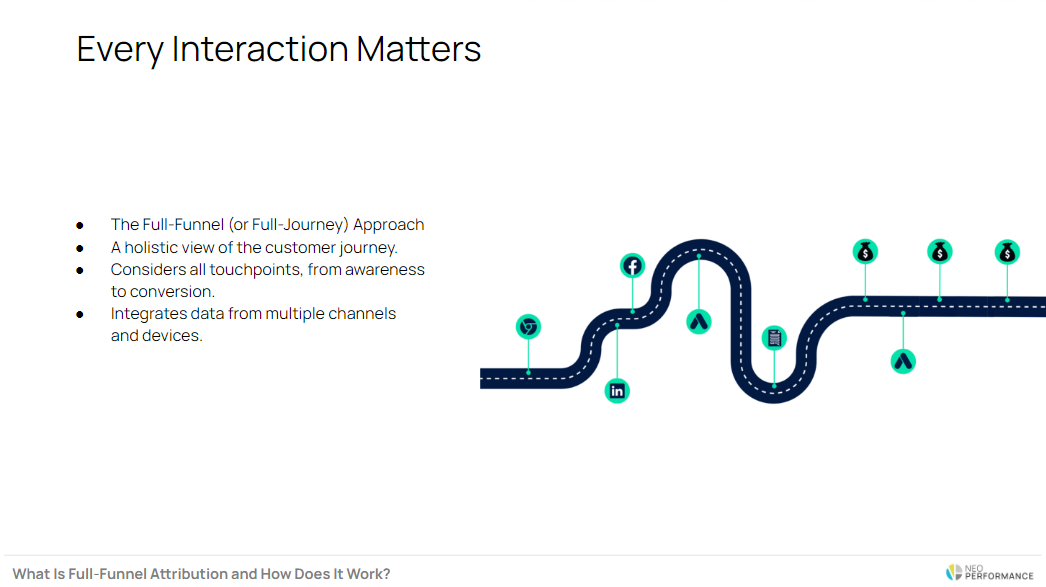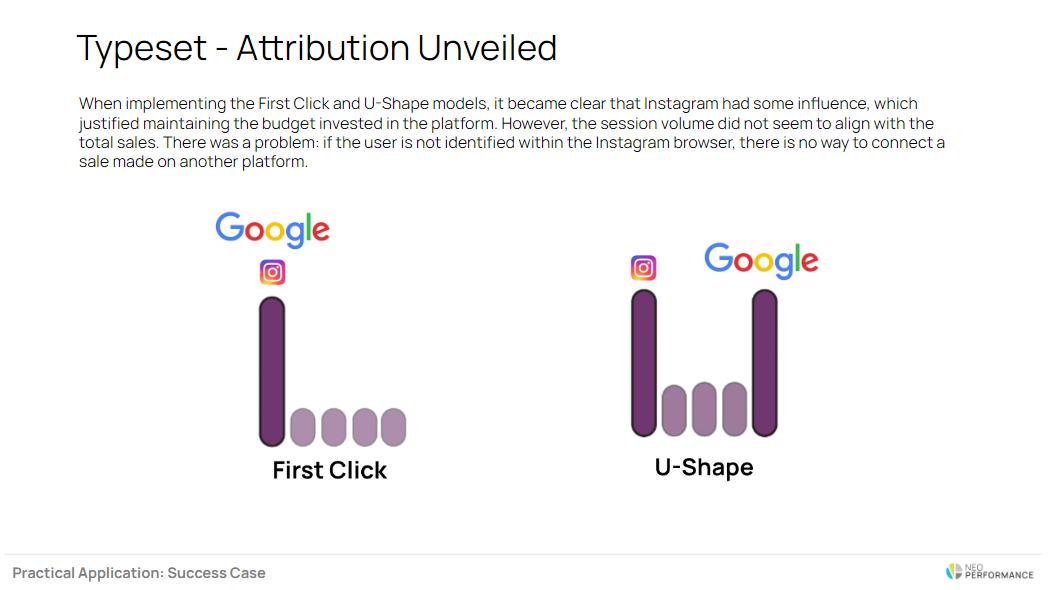Understanding the Customer's Next Steps: Strategies and Full-Funnel Attribution Models
- 10 minutes to read
In the dynamic landscape of digital marketing, understanding the customer’s next steps and correctly interpreting their behavior has become essential for achieving effective results. Full-funnel attribution provides a powerful tool for improving budget allocation efficiency and personalizing marketing strategies based on customer behavior. This methodology enhances the understanding of various touchpoints that influence the customer journey, optimizing marketing efforts and improving customer experience. However, transforming information into relevant results requires a detailed and precise view of the customer journey, something many companies are still struggling to achieve. So, how to improve?
Benefits of Full-Funnel Attribution
Efficiency in Budget Allocation:
Full-funnel attribution is a powerful tool for improving budget allocation efficiency. By understanding which channels and tactics generate the most impact at different stages of the funnel, companies can strategically and effectively distribute their budget, maximizing return on investment.
Personalization of Approaches:
This methodology enables the personalization of marketing strategies based on customer behavior. By better understanding interactions and preferences at each touchpoint, companies can create more targeted and relevant campaigns, increasing the likelihood of conversion and retention.
Understanding Customer Behavior:
Full-funnel attribution enhances the understanding of the various touchpoints that influence the customer journey. This holistic view helps identify which interactions are most effective in guiding customers through the sales funnel, optimizing marketing efforts and improving customer experience.
Data Analysis Across Multiple Platforms:
Utilizing data from multiple platforms, such as Facebook and Google, is fundamental to data-driven strategies. Full-funnel attribution integrates this information, offering a consolidated view that facilitates informed decision-making and more cohesive strategies.

Possible attribution models
Correctly attributing the value of each touchpoint in the customer journey is essential for optimizing marketing strategies. Attribution involves identifying and valuing the interactions and channels that contributed to the conversion, and distributing the conversion value according to the influence of each point. The main attribution models used in marketing are:
Last Click Attribution Model
The main advantage of this model is its simplicity and ease of implementation. On the other hand, it ignores all previous interactions that contributed to the conversion. This model is useful for remarketing campaigns where the last click is critical for the conversion.
In this model, the conversion is attributed exclusively to the customer’s last touchpoint before making the purchase. Its simplicity and ease of implementation are its main advantages. However, it disregards all previous interactions that contributed to the conversion. This model is especially useful for remarketing campaigns where the last click plays a crucial role in the conversion.
First Click Attribution Model
All credit for the conversion is attributed to the first touchpoint that introduced the customer to the product or service. The advantage of this model is that it highlights the initial discovery, evidencing the most effective acquisition channels. However, it ignores all subsequent interactions that influenced the conversion. It is ideal for campaigns focused on brand awareness and acquiring new customers.
Linear Model
In this model, the credit for the conversion is evenly distributed among all touchpoints in the customer’s journey. It offers a balanced view of each interaction. The disadvantage is that it does not differentiate the influence of each touchpoint. Thus, it is useful when all touchpoints have similar importance in the customer journey.
Time Decay Model
This model assigns more value to touchpoints closer to the conversion, reflecting the increasing importance of these points as the conversion approaches. While it may underestimate the relevance of the initial touchpoints, it is effective in campaigns where recent engagement plays a crucial role in the conversion.
U-Shaped Model
This model assigns 40% of the credit to the first and last touchpoints, distributing the remaining 20% among the intermediate touchpoints. It highlights the importance of the initial discovery and final conversion. It may underestimate the influence of intermediate touchpoints. Ideal for campaigns that emphasize discovery and closing the sale.
W-Shaped Model
This model distributes credit to the first touchpoint, the last touchpoint, and a specific intermediate touchpoint, while also dividing the remaining credit among the intermediate points. It considers the most critical interactions throughout the customer journey. This model can be complex to implement but is suitable for longer and more complex customer journeys.
Algorithmic or Data-Driven Model
It uses algorithms and historical data to attribute credit to each touchpoint based on its real contribution to the conversion. It offers the most accurate and personalized view of attribution but requires large volumes of data and advanced technology for its implementation. Ideal for companies with access to large amounts of data and robust analytical capabilities.
Different Funnel Models Bring Variety in Sales Visualization
By mapping the customer journey in detail, from initial awareness to post-purchase engagement, it is possible to identify critical points that can optimize future marketing strategies.
Full-funnel attribution not only optimizes marketing budgets but also improves the customer experience by offering more personalized interactions aligned with their needs. As data analysis finds application in various sectors, it demonstrates its versatility and effectiveness. For example, in e-commerce, it reveals which marketing channels truly influence purchase decisions. For SaaS companies and traditional retailers, it facilitates understanding how online and offline campaigns impact buying behavior.
To explore how these strategies connect and impact your marketing approach, you can check out our guide on designing an effective sales funnel, which offers additional insights into the customer journey and its relationship with full-funnel attribution.
Read more about full-funnel sales here.
Success Case: Typeset
Typeset, an innovative American startup, creates impactful presentations in minutes using artificial intelligence. NeoPerformance was strategically selected to elevate results, with the mission to scale investments and exponentially grow Typeset’s user base.
Initially, overall cost per sale showed great promise. However, the Last Click attribution model attributed 90% of sales to Google Search Ads and Organic Search, while the volume of website sessions from Meta properties, especially Instagram, was significant.

By implementing the First Click and U-Shape models, it became clear that Instagram had a significant influence, justifying maintaining the budget invested in the platform. However, the session volume did not match the total sales, indicating a problem: if the user is not identified within Instagram’s browser, there is no way to connect a sale made on another platform.
In collaboration with Meta’s team, NeoPerformance initiated an innovative Channel Lift study. For each conversion registered on Typeset’s servers, a data flow was meticulously constructed and sent to Meta via CApi. This data included not only last-click attribution information but also hashed user data, such as name and email.
This strategic process allowed Meta’s advanced algorithms to cross-reference information, revealing the direct influence of Meta ads on conversions. The study showed spectacular results: a 50% improvement in Cost Per Conversion with the integration of Meta channels.
Challenges and Ethical Issues in Full-Funnel Implementation
Implementing a full-funnel attribution strategy is a complex task filled with technical and operational challenges. Key challenges include data integration from multiple sources, data accuracy and integrity, and the complexity of data analysis in terms of costs and resources.
In addition to technical and operational challenges, full-funnel attribution raises several ethical issues that need to be carefully addressed, such as data privacy, cookies, fairness, and inclusion.
Successful implementation of full-funnel attribution requires not only a robust technical and operational approach but also a firm commitment to ethics and responsibility. Companies that navigate these challenges with integrity and transparency will be better positioned to leverage the benefits of full-funnel attribution while gaining the trust and loyalty of their customers.
Conclusion
NeoPerformance, with its vast experience and leadership in digital marketing, is equipped to help your company navigate these challenges and maximize results with full-funnel attribution. With a combination of technical knowledge and innovative strategies, NeoPerformance can transform complex data into extraordinary results, driving the growth and success of your business.
Share this post:




